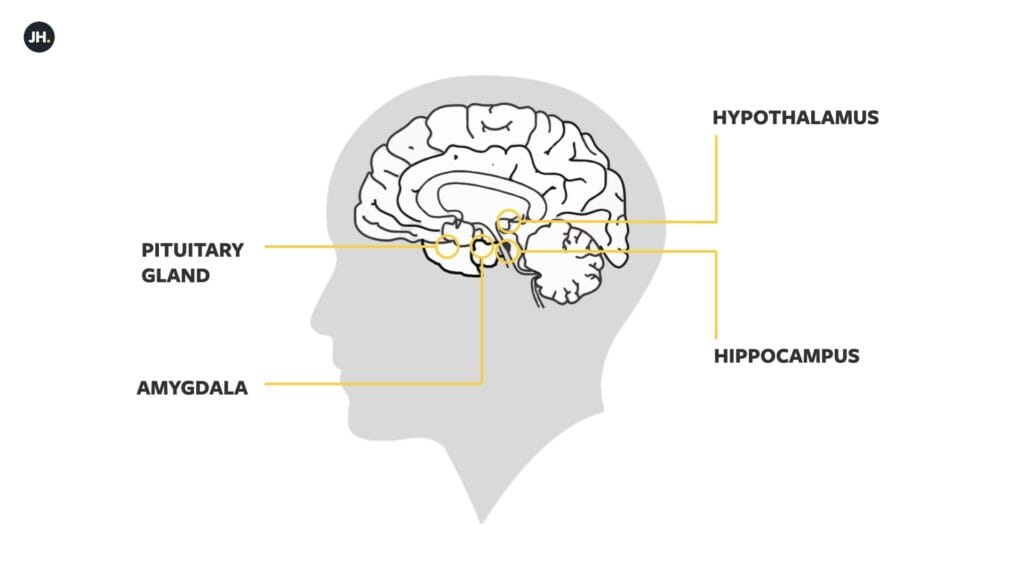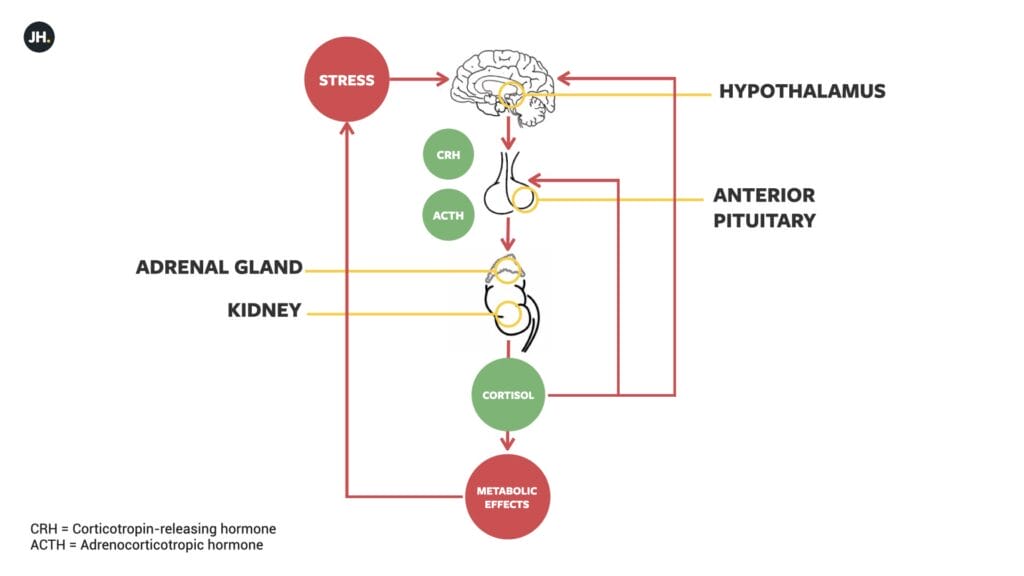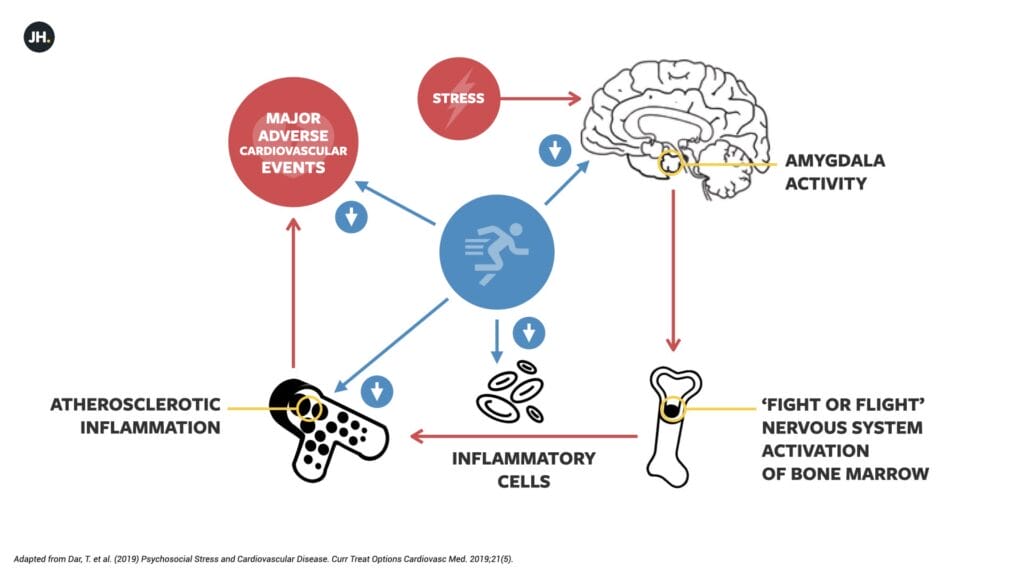Many people’s lives are characterised by multi-tasking, competition and time-pressure. The adverse effects of stress are common, and the costs to individuals and society are high in terms of both health and productivity. Amid our packed schedules, many of us are looking for time-efficient self-help techniques to reduce our stress. In this blog, you can find out more about the mechanisms which link stress and health, read about evidence-based stress reduction techniques, discover which appear to be the most effective approaches to reducing stress, and consider how you might be able to apply these approaches in your own life.
Understanding The Causes & Effects Of Stress
I sometimes feel that I spend most of my time and energy juggling competing priorities. I’m no stranger to the negative effects of stress, as I’m sure many of the readers of this article can relate. However, if I was to read many of the self-help articles that are scattered across the internet, I could quickly fill every waking moment with some kind of stress-reducing technique, without a clear idea of why I’m doing it, or whether it’s the most efficient route to the outcome I’m aiming for. The flipside of our societies stress epidemic is that a growing body of research is dedicated to understanding its causes, effects and solutions.
Stress Is Not Just ‘In Your Head’
Psychosocial stress describes the combined influence of psychological factors and the social environment on our levels of stress. Psychosocial stress can be chronic (long-lasting) or acute (short-term), and a lot of scientific research already describes the links between chronic psychosocial stress (CPS) to adverse outcomes in the cardiovascular system, such as coronary artery disease (CAD). There are also well-established links between acute psychosocial stress (APS) and coronary events (a coronary event is basically something bad happening to the blood vessels which supply the heart)1.
While psychosocial stress can begin with our thinking, when we feel there is an imbalance between the demands which are placed on us, and how we perceive our ability to manage these demands, I think that most people have moved beyond the idea that stress is ‘all in your head’. What happens between our ears has a cascading effect on our health and performance.
Understanding What Is Happening In Our Brain
A set of brain structures called the ‘limbic system’ plays a variety of essential roles associated with behaviour, judgment, insight, motivation, emotion, mood, the formation of memories and even our sense of smell. The role of the limbic system in our emotional life means that it’s no surprise that structures in this system are implicated in our experience and the outcomes of stress.
The Limbic System

Hypothalamus: Plays a crucial role in functions, including hormone release and the regulation of body temperature. Links the nervous system to the endocrine system via the pituitary gland.
Pituitary gland: Situated close to the hypothalamus, the pituitary gland is sometimes called the ‘master gland’. The hypothalamus controls the pituitary gland which in turn controls several other hormone glands in your body, including the thyroid and adrenal glands, the ovaries and testicles.
Hippocampus: Contributes to providing a spatial map of our environment, declarative memory (memory of facts and events) and helps control corticosteroid (stress hormone) production, among other functions.
Amygdala: A complex brain region with a wide range of functions including coordinating behavioural, autonomic and hormone responses to environmental stimuli, especially those with emotional content. The amygdala is sometimes described as the brains’ stress and fear centre.
A Leading Character In The Stress Story: The HPA Axis
The hypothalamic-pituitary-adrenal axis (HPA axis) describes the interaction between the hypothalamus, pituitary gland, and adrenal glands. This mechanism plays a central role in our response to stress.

Using Disaster Data To Demonstrate The Link Between Psychosocial Stress & Physical Health
It has long been hypothesised that there is a biological link between psychosocial stress and physical disease, and it is already clear that stress triggers increased sympathetic (fight or flight) nervous system activity, HPA axis activity and inflammation. Some of the data to describe the links between stress and health come from surprising sources.
Implantable cardioverter defibrillators (ICDs) are electronic devices, surgically placed in a patient’s chest to treat abnormal heart rhythms. Basically, if the ICD detects an irregular rhythm, it can either generate an electrical shock, to restore a normal rhythm, or act as a pacemaker, if the heart rate is too slow. Consequently, data from ICDs provide a source of information about instances of abnormal heart rhythms. This data can be correlated with information about events which may cause psychosocial stress, to better understand the links between these events and what is happening in the heart.
ICD devices detected and treated an unusually high number of abnormal heart rhythms in the months following the 2001 terrorist attack on the World Trade Center in New York, even when controlling for the severity of existing heart conditions2. Other studies have described how the chronic stress associated with upcoming deadlines at work was associated with a six-fold increase in the incidence of heart attacks3.
It’s only relatively recently that the mechanisms linking what happens in the brain, with what happens in the heart, have begun to be more clearly understood. The activity of the amygdala increases in response to chronic and perceived stress. The amygdala ‘sends signals’ which influence the HPA axis. Recently, a group of researchers hypothesised that increases in amygdala activity might be associated with cardiovascular disease via a pathway involving the sympathetic nervous system, white blood cell formation in bone marrow, increased inflammation in the arteries and, ultimately, disease.
Measuring Metabolic Rate In The Brain To Understand Stress Response
To test this hypothesis, the researchers used an imaging technique called ‘18F-FDG-PET/CT’ that is usually applied to detect certain types of cancer. The 18F-FDG part of the name stands for a type of radioactive glucose which emits particles called positrons. A PET (positron emission tomography) scanner can detect the positrons. Combined with CT (computed tomography) which uses X-ray measurements taken from different angles to produce cross-sectional images, researchers can understand more about the metabolic rate (energy expenditure) of particular tissues, which can assist with identifying certain cancers based on their location and unusual patterns of energy expenditure.

The researchers hypothesised that they would be able to use this technique to measure increased metabolic rates in the amygdala, which may indicate increased ‘stress and fear’ activity, at the same time as they measured white blood cell formation in the bone marrow (which is associated with ‘fight or flight’ nervous system activity), which in turn is associated with inflammation in the arteries, which eventually is related to cardiovascular disease. The researchers tracked 293 patients, without cardiovascular disease, for 5 years. The results provide support for this pathway and may assist in identifying targets for interventions designed to improve cardiovascular health by managing stress.
So What Does This Mean?
One of the most practical outcomes of this investigation is to highlight techniques which are designed to reduce amygdala activity in response to stress. This reduced activity should decrease the fight or flight reaction of the sympathetic nervous system, and decrease the adverse downstream effects resulting from this.
For example, some studies suggest that yoga – a practise which may increase parasympathetic (rest and digest) and decrease sympathetic (fight or flight) activity is an effective means to reduce cardiovascular disease risk4. Mindfulness-meditation based stress reduction techniques have also been demonstrated to lower blood pressure, potentially via changing the body’s inflammatory response5. While yoga and mindfulness are increasingly ‘in vogue’ stress management solutions, particularly in the corporate wellbeing space, simply exercising and being more physically active is one of the most dependable methods to manage stress and improve cardiovascular health more directly.
Exercise For The Brain & The Body
It’s well known that exercise improves heart health and the functioning of our blood cells, but it seems that exercise can also influence the functioning of the amygdala more directly.
A recent study suggests that exercise drives the interactions associated activity in the amygdala towards feelings of happiness and against fear6. Also, individuals who are more physically active appear to enjoy greater anxiety relief benefits. In short, if you want to maximise the stress-reducing effects of exercise, get active more often.
Comparing Physical Activity, Mindfulness Meditation, Or Heart Rate Variability Biofeedback
If you have a limited amount of time, which stress reduction technique is most effective, according to the available evidence? There are no definitive answers, but two recent randomised controlled trials, which compared three different types of stress reduction, provide some insights.
The first study compared physical activity, mindfulness meditation, or heart rate variability biofeedback for stress reduction7. The physical activity exercises consisted of 20 minutes of vigorous-intensity activity of free choice (such as a spin-cycling class). The mindfulness meditation exercises included a guided mindfulness meditation, involving sitting and focusing on the breath, a body scan, and mindful walking. The heart rate variability biofeedback exercises consisted of slow breathing with a heart rate variability biofeedback device, encouraging users to try to increase their heart rate variability by breathing at approximately six breaths per minute. The study found no significant differences, in terms of effects on stress reduction, between the three methods, concluding that they are all equally effective in reducing stress and its related symptoms.
The second study also compared physical activity, mindfulness meditation, or heart rate variability biofeedback, but considered slightly different outcomes. In addition to investigating stress reduction, the researchers also aimed to better understand the effects of these three practises on attention control, executive functioning, mindful awareness and self-compassion8. Again, the researchers concluded that physical activity, mindfulness meditation, and heart rate variability biofeedback were all effective self-help methods to improve attention control, executive functioning, mindful awareness, self-compassion, and worrying. They also noted that mindfulness meditation was not found to be more effective than HRV-biofeedback or physical exercise for these cognitive processes.

Personally, of these three techniques, I would favour physical exercise. My reasoning is that, if we are short of time, physical exercise has the advantage of influencing the amygdala, towards feelings of happiness and against fear, with downstream effects on cardiovascular health, as well as having a direct impact on inflammation and cardiovascular function, in addition to a host of other physical and cognitive and benefits. As little as 20 minutes of moderate-intensity exercise (65–70% VO2 peak) could have significant anti-inflammatory effects9, and even a short exercise session can boost cognitive performance, as a described in this blog.
In short, I think that physical exercise results in the best return on investment. If I only had 20 minutes per day to spare, I would probably choose to go for a short run or cycle. Ultimately, it’s up to you. Whatever you choose, the best technique for stress reduction is probably the one that you find easiest to stick to.
References
- Dar T, Radfar A, Abohashem S, Pitman RK, Tawakol A, Osborne MT. Psychosocial Stress and Cardiovascular Disease. Curr Treat Options Cardiovasc Med. 2019;21(5).
- Steinberg JS, Arshad A, Kowalski M, Kukar A, Suma V, Vloka M, et al. Increased incidence of life-threatening ventricular arrhythmias in implantable defibrillator patients after the World Trade Center attack. J Am Coll Cardiol [Internet]. 2004;44(6):1261–4.
- Johansen C, Feychting M, Møller M, Arnsbo P, Ahlbom A, Olsen JH. Risk of severe cardiac arrhythmia in male utility workers: A nationwide Danish cohort study. Am J Epidemiol. 2002;156(9):857–61.
- Chu P, Pandya A, Salomon JA, Goldie SJ, Hunink MGM. Comparative effectiveness of personalized lifestyle management strategies for cardiovascular disease risk reduction. J Am Heart Assoc. 2015;5(3):1–16.
- Bhasin MK, Denninger JW, Huffman JC, Joseph MG, Niles H, Chad-Friedman E, et al. Specific Transcriptome Changes Associated with Blood Pressure Reduction in Hypertensive Patients after Relaxation Response Training. J Altern Complement Med. 2018;24(5):486–504.
- Chen YC, Chen C, Martínez RM, Etnier JL, Cheng Y. Habitual physical activity mediates the acute exercise-induced modulation of anxiety-related amygdala functional connectivity. Sci Rep. 2019;9(1):1–12.
- van der Zwan JE, de Vente W, Huizink AC, Bögels SM, de Bruin EI. Physical Activity, Mindfulness Meditation, or Heart Rate Variability Biofeedback for Stress Reduction: A Randomized Controlled Trial. Appl Psychophysiol Biofeedback. 2015;40(4):257–68.
- de Bruin EI, van der Zwan JE, Bögels SM. A RCT Comparing Daily Mindfulness Meditations, Biofeedback Exercises, and Daily Physical Exercise on Attention Control, Executive Functioning, Mindful Awareness, Self-Compassion, and Worrying in Stressed Young Adults. Mindfulness (N Y) [Internet]. 2016;7(5):1182–92.
- Dimitrov S, Hulteng E, Hong S. Inflammation and exercise: Inhibition of monocytic intracellular TNF production by acute exercise via β2-adrenergic activation. Brain Behav Immun [Internet]. 2017;61:60–8.

